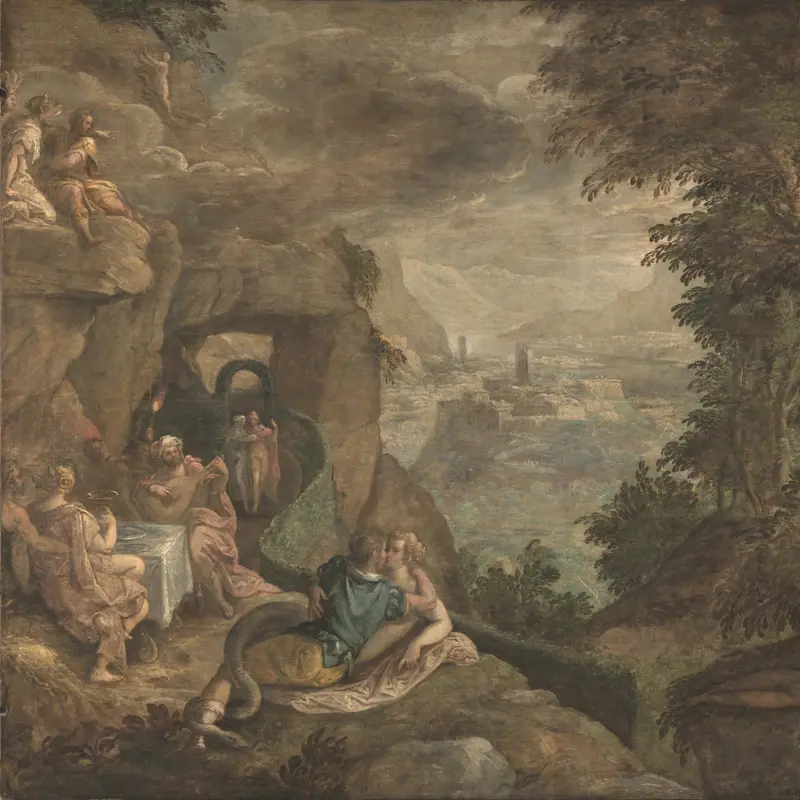Paolo Fiammingo, 'Landscape with a Scene of Enchantment', about 1590
About the work
Overview
A maze or rocky grotto looks out over a cloudy mountainous landscape and meandering river. A turbaned man plays a lute by torchlight as three others embrace bizarre hybrid women. One has a serpent for a tail, another has the face of a pig, a third has the head of a reptile. Two turbaned figures, emerging from the maze, embrace and talk to one another, while a naked bearded man lies sleeping near the edge of a cliff. At the top of the picture another naked figure seems to slide into the clouds. The very specific elements in this scene suggest that it illustrates a particular story, although we do not know which.
This and another National Gallery picture, Landscape with the Expulsion of the Harpies, may once have been part of a series of paintings intended to cover the upper walls of a whole room in a Venetian palace.
Key facts
Details
- Full title
- Landscape with a Scene of Enchantment
- Artist
- Paolo Fiammingo
- Artist dates
- About 1540 - 1596
- Part of the series
- Two Scenes from the Argonautica
- Date made
- About 1590
- Medium and support
- Oil on canvas
- Dimensions
- 185 × 206.5 cm
- Acquisition credit
- Bought, 1944
- Inventory number
- NG5466
- Location
- Not on display
- Collection
- Main Collection
Provenance
Additional information
Text extracted from the ‘Provenance’ section of the catalogue entry in Nicholas Penny, ‘National Gallery Catalogues: The Sixteenth Century Italian Paintings’, vol. 2, ‘Venice 1540–1600’, London 2008; for further information, see the full catalogue entry.
Bibliography
-
1955The National Gallery, The National Gallery: 1938-1954, London 1955
-
1959Gould, Cecil, National Gallery Catalogues: The Sixteenth Century Venetian School, London 1959
-
1959R. Pallucchini, La pittura veneziana del Seicento, vol. 1, Padua 1959
-
1965S. Mason Rinaldi, 'Appunti per Paolo Fiammingo', Arte veneta, XIX, 1965, pp. 95-107
-
1975C. Gould, Delaroche and Gautier: Gautier's Views on the 'Execution of Lady Jane Grey' and on other Compositions by Delaroche, London 1975
-
1978S. Mason Rinaldi, 'Paolo Fiammingo', Saggi et memorie di storia dell'arte, XI, 1978, pp. 47-80
-
1979C. Limentani Virdis, 'Un catalogo per Paolo Fiammingo', Antichità viva, XVIII/2, 1979, pp. 49-50
-
1987Gould, Cecil, National Gallery Catalogues: The Sixteenth Century Italian Schools, London 1987
-
1993A. Walther, Von Göttern, Nymphen und Heroen: Die Mythen der Antike in der bildenden Kunst, Leipzig 1993
-
1999B. Aikema and B.L. Brown (eds), Renaissance Venice and the North: Crosscurrents in the Time of Bellini, Dürer and Titian, (exh. cat. Palazzo Grassi, 5 September 1999 - 9 January 2000), Milano 1999
-
2001
C. Baker and T. Henry, The National Gallery: Complete Illustrated Catalogue, London 2001
-
2004F. Pedrocco, Ca' Vendramin Calergi, Venice 2004
-
2005M. Spring, C. Higgitt and D. Saunders, 'Investigation of Pigment-Medium Interaction Processes in Oil Paint containing Degraded Smalt', National Gallery Technical Bulletin, XXVI, 2005, pp. 56-70
-
2008Penny, Nicholas, National Gallery Catalogues: The Sixteenth Century Italian Paintings, 2, Venice, 1540-1600, London 2008
About this record
If you know more about this work or have spotted an error, please contact us. Please note that exhibition histories are listed from 2009 onwards. Bibliographies may not be complete; more comprehensive information is available in the National Gallery Library.
Images
About the series: Two Scenes from the Argonautica

Overview
These two very large canvases may once have been part of a series of perhaps six or more paintings which would have decorated the walls of a whole room in a Venetian palace, like wallpaper today. They were painted hastily using only a limited range of colours, which may be because they were intended as interior decoration rather than as gallery pictures.
Landscape with the Expulsion of the Harpies illustrates a scene from the Argonautica, an epic romance written by Apollonius Rhodius in the third century BC. The hybrid women in Landscape with a Scene of Enchantment could be beastly followers of Circe also described in the Argonautica (Book IV) and the sleeping man may be Odysseus. The very specific elements in this scene suggest that it illustrates a particular story, although we do not know which one.


